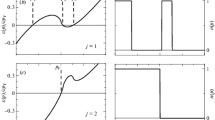Abstract
We show that all the Bose–Einstein (BE) condensations of Bose and Fermi systems can be formulated using the common ‘boson’ operator (valid below the BE condensation temperature \(T_{c}\)) with the coherent translational momentum \({{\varvec{q}}}=0\) (center-of-mass momentum in fermion system). The BE condensation is identified as the condensate of hopping bosons in Bose system and hopping fermion-pairs in Fermi system and the condensation energy is given by those average hopping energy times their condensate. We demonstrate that this scheme is actually working in all the BE condensations of strong-coupling fermion-pair system, weak-coupling Cooper-pair BCS system and the ideal Bose gas system. We find that the change of cuprate high-\(T_{c}\) superconductivity from the underdoped to the overdoped regime is the doping-induced crossover from strong- to weak-coupling BE condensation arising from the same origin of the attractive superexchange interaction. We also study the BE condensation in the large attractive \(-U\) Hubbard model and obtain a new BE-condensed ground state which is different from the one considered hitherto. We briefly comment on the more recently discovered BE condensations and their crossovers in the ultra-cold alkaline Fermi atom gases.
Graphical abstract




Similar content being viewed by others
Data availability statement
This manuscript has no associated data or the data will not be deposited. [Author’s comment: This is a self-contained analytical theory paper and all the necessary data that were used are included in the manuscript.].
Notes
We correct an error in the previous paper Ref. [24] for the estimation of the doped antiferromagnetic energy \(<H>_{AF}\) and take into account the superconducting phase instead of the insulating phase for the singlet-bond energy \(<H>_{SB}\).
References
A. Einstein, Sitzungsberichte, Preuss. Akad. Wiss. Phys.-Math. Kl. (1924)
A. Einstein, Sitzungsberichte. Preuss. Akad. Wiss. Phys.-Math. Kl. 3, 18 (1925)
P.T. Landsberg, Proc. Camb. Phil. Soc. 50, 65 (1954)
F. London, Nature 141, 643 (1938)
F. London, Phys. Rev. 54, 947 (1938)
F. London, Superfluids, vol. 2 (John-Wiley and Sons Inc., New York, 1954), pp.40-58–199-201
O. Penrose, L. Onsager, Phys. Rev. 104, 576 (1956)
A.J. Leggett, Rev. Mod. Phys. 47, 331 (1975)
A.J. Leggett, Modern trends in the theory of condensed matter, in Proceedings of the XVIth Karpacz Winter School of Theoretical Physics, Karpacz, Poland. ed. by M. Ch (Springer-Verlag, Berlin, 1980), pp.13–27
P. Nozières, S. Schmitt-Rink, J. Low Temp. Phys. 59(3/4), 195 (1985)
P.W. Anderson, W.F. Brinkman, The Helium Liquids: Proceedings of the 15th Scottish Universities Summer School in Physics (Academic Press, New York, 1975)
J. Bardeen, L.N. Cooper, J.R. Schrieffer, Phys. Rev. 108, 1175 (1957)
J.G. Bednorz, K.A. Müller, Z. Phys. B 64, 189 (1986)
J. Orenstein, A.J. Mills, Science 288, 468 (2000)
T. Schneider, J.M. Singer, Phase Transition Approach to High Temperature Superconductivity (Imperial College Press, London, 2000)
P.W. Anderson, The Theory of Superconductivity in the High-Tc Cuprates (Princeton University Press, Princeton, 1997)
C.A. Regal et al., Phys. Rev. Lett. 92, 040403 (2004)
M.W. Zwierlein et al., Phys. Rev. Lett. 92, 120403 (2004)
J. Kinast et al., Phys. Rev. Lett. 92, 150402 (2004)
T. Bourdel et al., Phys. Rev. Lett. 93, 050401 (2004)
C. Chin et al., Science 305, 1128 (2004)
G.B. Partridge et al., Phys. Rev. Lett. 95, 020404 (2005)
M.W. Zwierlein et al., Nature 435, 1047 (2005)
H. Kaga, Eur. Phys. J. B 95, 72 (2022)
J.R. Schrieffer, Theory of Superconductivity (W. A. Benjamin Inc Publishers, New York, 1964)
M. Tinkham, Introduction to Superconductivity (McGraw-Hill Inc, NewYork, 1996)
H. Takagi et al., Phys. Rev. B 40, 2254 (1989)
J.B. Torrance et al., Phys. Rev. B 40, 8872 (1989)
T. Nakano et al., Phys. Rev. B 48, 9689 (1993)
Y. Fukuzumi et al., Phys. Rev. Lett. 76, 684 (1996)
B. Loret et al., Phys. Rev. B 96, 094525 (2017)
F.C. Zhang, T.M. Rice, Phys. Rev. B 37, 3759 (1988)
M. Randeria et al., Phys. Rev. Lett. 62, 981 (1989)
M. Randeria et al., Phys. Rev. B 41, 327 (1990)
J.M. Singer et al., Phys. Rev. B 54, 1286 (1996)
J.M. Singer et al., Eur. Phys. J. B 2, 17 (1998)
J.M. Singer et al., Physica C 302, 183 (1998)
J.M. Singer et al., Eur. Phys. J. B 7, 37 (1999)
W. Zwerger, Lecture notes in physics, in The BCS-BEC Crossover and the Unitary Fermi Gas. (Springer, Berlin, 2011)
W. Ketterle, M.W. Zwierlein, Making, probing and understanding ultra-cold Fermi gases, in Ultra-Cold Fermi Gases, Proceedings of the International School of Physics, “Enrico Fermi’’, Course CLXIV, Varenna, 20-30 June 2006. ed. by M. Inguscio, W. Ketterle, C. Salomon (IOS Press, Amsterdam, 2008)
I. Bloch, J. Dalibard, W. Zwerger, Rev. Mod. Phys. 80(3), 885–964 (2008)
S. Giorgini, L.P. Pitaevskii, S. Stringari, Rev. Mod. Phys. 80(4), 1215–1274 (2008)
Q. Chen, J. Stajic, S. Tan, K. Levin, Phys. Rep. 412(1), 1–88 (2005)
M. Randeria, E. Taylor, Ann. Rev. Condens. Matter Phys. 5, 209–232 (2014)
M.W. Zwierlein et al., Phys. Rev. Lett. 94, 180401 (2005)
Author information
Authors and Affiliations
Corresponding author
Rights and permissions
Springer Nature or its licensor (e.g. a society or other partner) holds exclusive rights to this article under a publishing agreement with the author(s) or other rightsholder(s); author self-archiving of the accepted manuscript version of this article is solely governed by the terms of such publishing agreement and applicable law.
About this article
Cite this article
Kaga, H. A unified picture of the Bose–Einstein condensation in Fermi and Bose systems. Eur. Phys. J. B 96, 71 (2023). https://doi.org/10.1140/epjb/s10051-023-00519-w
Received:
Accepted:
Published:
DOI: https://doi.org/10.1140/epjb/s10051-023-00519-w



